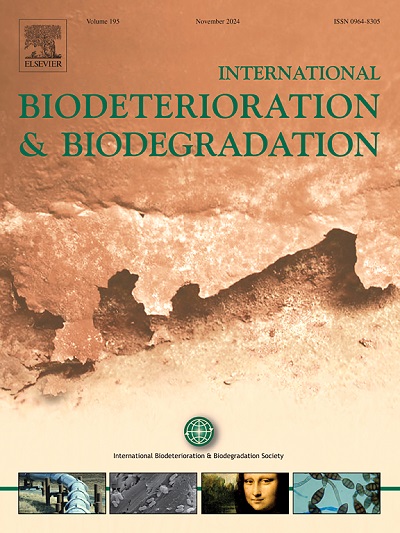Biochar's multifaceted role in bioremediation of emerging contaminants and heavy metals in complex rhizospheric ecosystem
IF 4.1
2区 环境科学与生态学
Q2 BIOTECHNOLOGY & APPLIED MICROBIOLOGY
International Biodeterioration & Biodegradation
Pub Date : 2025-02-01
DOI:10.1016/j.ibiod.2025.106005
引用次数: 0
Abstract
Rising prevalence of emerging contaminants (ECs) and priority heavy metals (PHMs) poses grave threats to the health of the environment and humankind, majorly resulting from human activity such as mining, disposal of industrial wastes, and use of chemicals. These pollutants drastically reduce soil biodiversity, fertility, and crop yield, rendering agricultural goods hazardous. Biochar has recently received attention as a sustainable bioremediation solution for ECs and PHMs through diverse physical, chemical, and biological processes. Biochar has demonstrated significant bioremediation efficiency for PAHs, antibiotics, microplastics, and pesticides varied from 50 to 95% and 60–90% for PHMs in a wide range of ecosystems. The interactive mechanisms of complexation, precipitation, ion exchange, surface sorption, and electrostatic interaction, hydrophobic interaction electron donor and acceptor interaction altogether enhance contaminant immobilization and biodegradation. Furthermore, biochar has been shown to aid in the breakdown of contaminants while lowering the transportation and accessibility of heavy metals. Besides remediation, biochar improves the rhizospheric environment by enhancing plant growth, nutrient uptake, and soil vitality. Its ability to remove both heavy metals and organic pollutants from wastewater and soil matrices, and its influence on their bioavailability and transport, show the dual nature of biochar in restoring environments. This manuscript attempts to provide in-depth insight into the challenges that ECs and PHMs pose, the role of biochar in their removal, and delicate soil-plant-biochar interactions. The work here discusses these interacting effects, thus giving insight into the potential of biochar in the immobilization of ECs and PHMs through many interspecific reactions, and also the soil-plant-biochar interactions and possibilities for successful remediation.

生物炭在复杂根际生态系统中新出现的污染物和重金属的生物修复中的多重作用
新出现的污染物(ECs)和重点重金属(PHMs)日益普遍,对环境和人类的健康构成严重威胁,主要是采矿、工业废物处置和化学品使用等人类活动造成的。这些污染物大大降低了土壤的生物多样性、肥力和作物产量,使农产品变得危险。生物炭作为一种通过多种物理、化学和生物过程对ECs和phm进行可持续生物修复的解决方案,最近受到了人们的关注。在广泛的生态系统中,生物炭对多环芳烃、抗生素、微塑料和农药的生物修复效率在50%至95%之间,对PHMs的生物修复效率在60-90%之间。络合、沉淀、离子交换、表面吸附、静电相互作用、疏水相互作用、电子供体和受体相互作用等相互作用机制共同促进了污染物的固定化和生物降解。此外,生物炭已被证明有助于污染物的分解,同时降低重金属的运输和可及性。除了修复外,生物炭还通过促进植物生长、养分吸收和土壤活力来改善根际环境。它从废水和土壤基质中去除重金属和有机污染物的能力,以及它对它们的生物可利用性和运输的影响,显示了生物炭在恢复环境中的双重性质。本文试图深入了解ECs和phm构成的挑战,生物炭在其去除中的作用,以及微妙的土壤-植物-生物炭相互作用。本文讨论了这些相互作用效应,从而深入了解了生物炭通过多种种间反应固定化ECs和phm的潜力,以及土壤-植物-生物炭的相互作用和成功修复的可能性。
本文章由计算机程序翻译,如有差异,请以英文原文为准。
求助全文
约1分钟内获得全文
求助全文
来源期刊
CiteScore
9.60
自引率
10.40%
发文量
107
审稿时长
21 days
期刊介绍:
International Biodeterioration and Biodegradation publishes original research papers and reviews on the biological causes of deterioration or degradation.

 求助内容:
求助内容: 应助结果提醒方式:
应助结果提醒方式:


